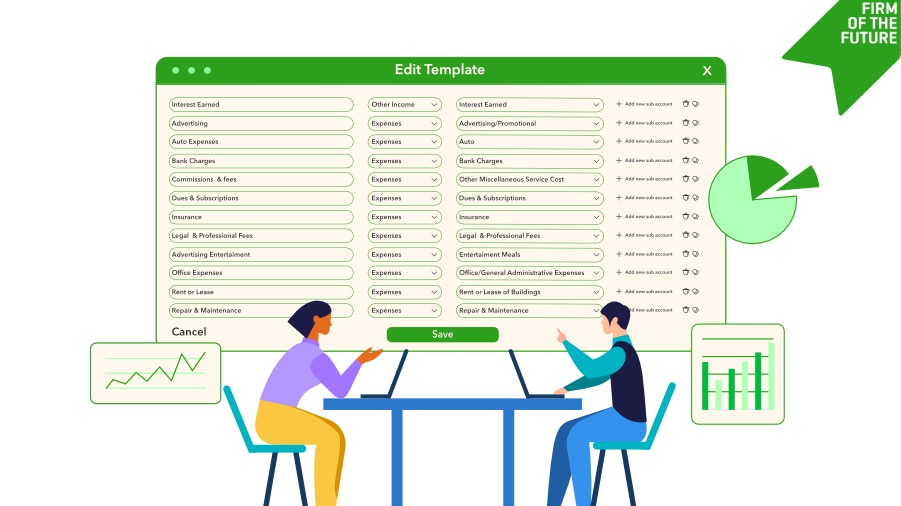A core part of onboarding a new client to your practice is finding out what technology products they are using to run their business. The technology stack is often foundational for how an accountant will work with their client, not just in bookkeeping, but also in advising the client on best practices to grow their business.
Technology is an investment for a business, and although conversations about optimizing current products or making a change to options that are a better fit for the client can be sensitive, these discussions are important for the client and for your practice’s efficiency.
We talked with two accountants—one from a small firm and one from a large firm—on how they approach these initial technology conversations during the client onboarding process, and how crucial these discussions are as a part of the client onboarding experience.
Here are five areas they highlighted to help you have successful technology conversations with potential clients.
1. Fact find early
Have technology conversations in the early stages of the onboarding process. Tina Hendry, a partner at GranthamPoole, said the firm begins assessing the potential client’s technology setup in the initial proposal conversation.
“In that first meeting, we have a tax person, client advisory services person, and representation from any other area the client mentions they want to talk about,” said Tina. “In that meeting, I'm asking, ‘What's your accounting software? How are you paying bills? Who's your payroll provider? Do you have a payroll provider?’ I'm also asking what other software they use and why. If I don't know, I'm going to investigate to see if they integrate with QuickBooks Online because that's the core software we're using. So once I have that list, I pretty much know what we're keeping and what we're not. And then the client has to buy in [to those decisions].”
Keila Hill-Trawick, founder and CEO of Little Fish Accounting, asks for technology information in an initial intake form a potential client fills out before anyone from the firm sets up a meeting. The intake form allows her team to be best prepared for the subsequent conversations.
“There are some [prospects] we won't move on,” she said. “We're a QuickBooks Online shop. We say on the form that if you're not on QuickBooks Online or willing to change, we're not the right fit for you. Part of our process is you have to do the thing we ask you to do.”
Waiting to have technology conversations can impact everything from the scope of the engagement to assembling the best team to work with the client. Having technology information early in the process allows for a smooth transition into a better working relationship with the client.
2. Do not shy away from recommendations
Clients are approaching accountants because they need someone they can trust to be a second set of eyes on their business operations. The clients are bringing what they know and see about their business, but are often open to what you can see from a different perspective.
“They trust us as their experts, but a lot of business owners are only using what they know,” said Hendry. “However, if you knew that the client could be getting, for example, automated automatic reports they are not getting because they are using system A instead of system B, you can take the opportunity to show your expertise.”
Hendry noted that many businesses use the same core accounting or financial management systems such as QuickBooks Online, but often struggle knowing which integrations can help their business run more efficiently.
“With point of sale systems and apps like inventory plug-in systems, you have expertise and add some support where it's lacking,” she said. “But you've got to be careful about how you choose those recommendations and how they work with your core system.”
In making recommendations, be sure to state clearly what the implementation process will be.
“Make sure your clients understand their responsibility in these changes,” said Hill-Trawick. “If we are recommending software, that doesn’t make us the people that have to implement it for you. We may be recommending it and supporting you through adding it to your company. But we also want to make sure the client has a really clear understanding of what they will be responsible for in doing this and what we are all taking on.”
3. Standardization is crucial
It's tempting to try to help all clients, no matter what technology they use, but there are benefits for practices to use a set of technology systems for their clients.
“It's the only way you can be efficient, especially as a very small team, and the only way to not have to take on a million clients and hire a ton of people to support them,” said Hill-Trawick. “The more anomalies you have in your process, the more changes you have in your systems and the more people have to be involved, whether that is internal or outsourced IT support.”
She also noted that standardization gives her team the opportunity to become software experts.
“The other thing I'll say is that it creates our ability to be really good at those technologies,” she said. “When something comes up, there's a person on the inside—a software champion—who can really support them through it. If you let clients come in with whatever they want to, it is very difficult to be good at it all.”
4. If there are anomalies, be sure to adjust your fee structure
At times, clients will have complex data structures or systems that will be difficult to migrate to other software options. If you choose to work with the client and have to adjust your workflows to accommodate their structure, be sure to adjust what you are charging the client.
Hill-Trawick shared this example:
“If you're using this payroll software, I've already got some integrations that work for that; it’s going to feed directly what I need. But if you're using this other one, I have to manually do it in a different way and that should cost you more. Can I log in with my own login or does it send an MFA code to your phone, and then I have to wait and then I have to get some more information?
“Use this client onboarding process to really determine how much it should cost for ongoing service based on their tech stack,” she continued. “Let's say you're working with a therapist, doctor's office, or a lawyer, and they've got some internal systems you can't really change. Maybe that alters your process, and as a result, there is going to be a bit of an anomaly. You want to make sure you're charging for the extra work.”
There may be challenges
Recommending technology that can be the best fit for your clients is not without challenges. Clients can be reluctant to change or may not feel they have the bandwidth to migrate to a different system. This is where the foundation for advisory can begin in this new accountant/client relationship.
“There’s a lot of talk in our industry right now around advisory, so it gives us the opportunity to go ahead and start with some best practices,” said Hendry, who gives an example of asking what the client has been using for payroll. “We say, ‘Based on the ways I see that this is coming in, we really recommend you use this other system, so let's get that in now. Do we have access to the systems, processes, bank accounts, and all of those things?’”
Hendry notes that in a larger firm, there are often more stakeholders involved in technology decisions, making standardization an internal change management process as well.
Accounting practices and firms of all sizes can benefit from productive technology conversations in the client onboarding process. Structuring these conversations provides the information needed to transition the client into the best working relationship possible for your firm and ensures the client has the best software to help their business grow.
For more information on providing more-thorough technology information to your clients, schedule a consultation with our QuickBooks team.



